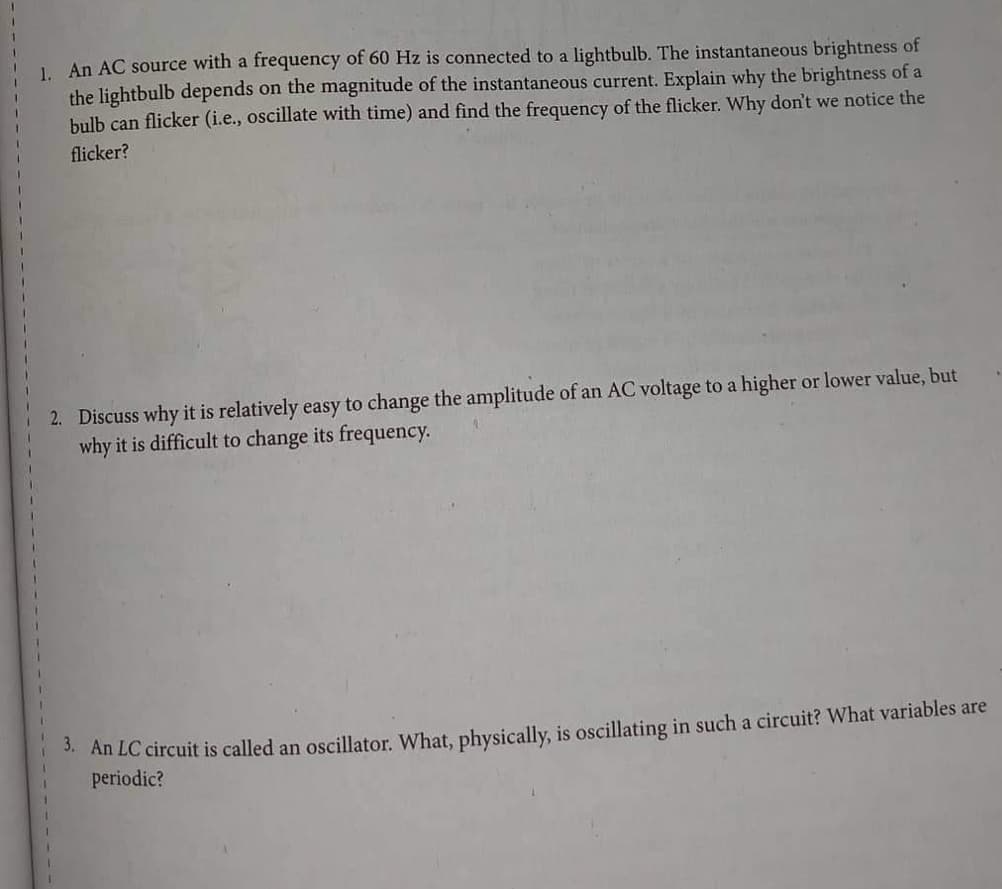1. An AC source with a frequency of 60 Hz is connected to a lightbulb. The instantaneous brightness of the lightbulb depends on the magnitude of the instantaneous current. Explain why the brightness of a bulb can flicker (i.e., oscillate with time) and find the frequency of the flicker. Why don't we notice the flicker?
1. An AC source with a frequency of 60 Hz is connected to a lightbulb. The instantaneous brightness of the lightbulb depends on the magnitude of the instantaneous current. Explain why the brightness of a bulb can flicker (i.e., oscillate with time) and find the frequency of the flicker. Why don't we notice the flicker?
Physics for Scientists and Engineers, Technology Update (No access codes included)
9th Edition
ISBN:9781305116399
Author:Raymond A. Serway, John W. Jewett
Publisher:Raymond A. Serway, John W. Jewett
Chapter33: Alternating Current Circuits
Section: Chapter Questions
Problem 33.80CP: P33.80a shows a parallel RLC circuit. The instantaneous voltages (and rms voltages) across each of...
Related questions
Question

Transcribed Image Text:1. An AC source with a frequency of 60 Hz is connected to a lightbulb. The instantaneous brightness of
the lightbulb depends on the magnitude of the instantaneous current. Explain why the brightness of a
bulb can flicker (i.e., oscillate with time) and find the frequency of the flicker. Why don't we notice the
flicker?
2. Discuss why it is relatively easy to change the amplitude of an AC voltage to a higher or lower value, but
why it is difficult to change its frequency.
3. An LC circuit is called an oscillator. What, physically, is oscillating in such a circuit? What variables are
periodic?
Expert Solution
This question has been solved!
Explore an expertly crafted, step-by-step solution for a thorough understanding of key concepts.
This is a popular solution!
Trending now
This is a popular solution!
Step by step
Solved in 5 steps

Knowledge Booster
Learn more about
Need a deep-dive on the concept behind this application? Look no further. Learn more about this topic, physics and related others by exploring similar questions and additional content below.Recommended textbooks for you

Physics for Scientists and Engineers, Technology …
Physics
ISBN:
9781305116399
Author:
Raymond A. Serway, John W. Jewett
Publisher:
Cengage Learning


Physics for Scientists and Engineers: Foundations…
Physics
ISBN:
9781133939146
Author:
Katz, Debora M.
Publisher:
Cengage Learning

Physics for Scientists and Engineers, Technology …
Physics
ISBN:
9781305116399
Author:
Raymond A. Serway, John W. Jewett
Publisher:
Cengage Learning


Physics for Scientists and Engineers: Foundations…
Physics
ISBN:
9781133939146
Author:
Katz, Debora M.
Publisher:
Cengage Learning

College Physics
Physics
ISBN:
9781285737027
Author:
Raymond A. Serway, Chris Vuille
Publisher:
Cengage Learning

College Physics
Physics
ISBN:
9781305952300
Author:
Raymond A. Serway, Chris Vuille
Publisher:
Cengage Learning

Physics for Scientists and Engineers
Physics
ISBN:
9781337553278
Author:
Raymond A. Serway, John W. Jewett
Publisher:
Cengage Learning